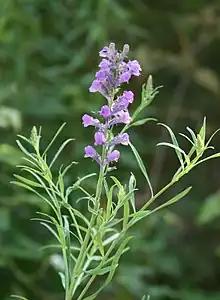Linaria purpurea
Linaria purpurea or purple toadflax is a purple-flowered plant native to Italy, part of the plantain family (Plantaginaceae). It is sometimes planted in gardens and is also an introduced weed in North America and other parts of Europe.[2][3]
| Linaria purpurea | |
|---|---|
 | |
| Scientific classification | |
| Kingdom: | Plantae |
| Clade: | Tracheophytes |
| Clade: | Angiosperms |
| Clade: | Eudicots |
| Clade: | Asterids |
| Order: | Lamiales |
| Family: | Plantaginaceae |
| Genus: | Linaria |
| Species: | L. purpurea |
| Binomial name | |
| Linaria purpurea | |
| Synonyms[1] | |
| |
Description

It is a perennial herbaceous plant growing 30 to 70 centimeters tall with linear leaves 2 to 5 centimeters in length. The inflorescence is a raceme of flowers occupying the top of the stem. The flower is between 1 and 2 centimeters long with five lobes arranged into two lips with a spur at the end. The flower is usually light to medium purple in color. The fruit is a capsule.
There is a pale pink cultivar of the species named 'Canon Went'.[4]
Range
It is native to Italy,[5] but it can be found growing wild as an introduced species in parts of western North America, including California,[6] western Washington,[7] and British Columbia,[3] and it is cultivated as an ornamental plant.[8] It occurs naturally in moist, moderately nutrient-rich places. In the UK it is regarded as something of a weed, spreading readily on stony waste ground and walls, although it is tolerated for its attractive, long-lasting flowers which are very attractive to bees.[9]
Toxicity and chemistry
This plant is poisonous to livestock, though ruminants may tend to avoid consuming it. The larvae of some species of Lepidoptera (butterflies) use this plant as a food source.[10] In a recent study conducted in Italy the plant was found to contain a compound exhibiting antifungal activity, which drastically reduced the production of aflatoxin B1 in Aspergillus flavus Link., making it a potential natural and 'green' anti-aflatoxin B1 agent suitable for use in the food industry.[11]
References
- The Plant List: A Working List of All Plant Species, retrieved 13 September 2016
- BSBI List 2007 (xls). Botanical Society of Britain and Ireland. Archived from the original (xls) on 2015-06-26. Retrieved 2014-10-17.
- USDA, NRCS (n.d.). "Linaria purpurea". The PLANTS Database (plants.usda.gov). Greensboro, North Carolina: National Plant Data Team. Retrieved 26 January 2016.
- "Linaria purpurea 'Canon Went' | purple toadflax 'Canon Went' Herbaceous Perennial/RHS Gardening".
- "Linaria purpurea". Germplasm Resources Information Network. Agricultural Research Service, United States Department of Agriculture. Retrieved 19 January 2018.
- Jepson Manual Treatment
- Burke Museum
- Kemper Garden Center
- "Alys Fowler: toadflax". The Guardian. 2013-04-27. Retrieved 2022-11-18.
- "Purple Toadflax - Linaria purpurea, species information page". www.brickfieldspark.org. Retrieved 2016-06-30.
- https://www.researchgate.net/publication/334596739_Phytochemical_analysis_of_Linaria_purpurea_L_Mill_and_inhibitory_activity_on_the_production_of_aflatoxin_B1_AFB1_in_Aspergillus_flavus_Link_of_one_of_its_metabolites_antirrhinoside Abstract: Frezza, C., Venditti, A., Marcucci, E. and Parroni, A. Industrial Crops and Products Vol. 139, 1 November 2019 "Phytochemical analysis of Linaria purpurea (L.) Mill. and inhibitory activity on the production of aflatoxin B1 (AFB1) in Aspergillus flavus Link. of one of its metabolites, antirrhinoside"
External links
![]() Media related to Linaria purpurea at Wikimedia Commons
Media related to Linaria purpurea at Wikimedia Commons